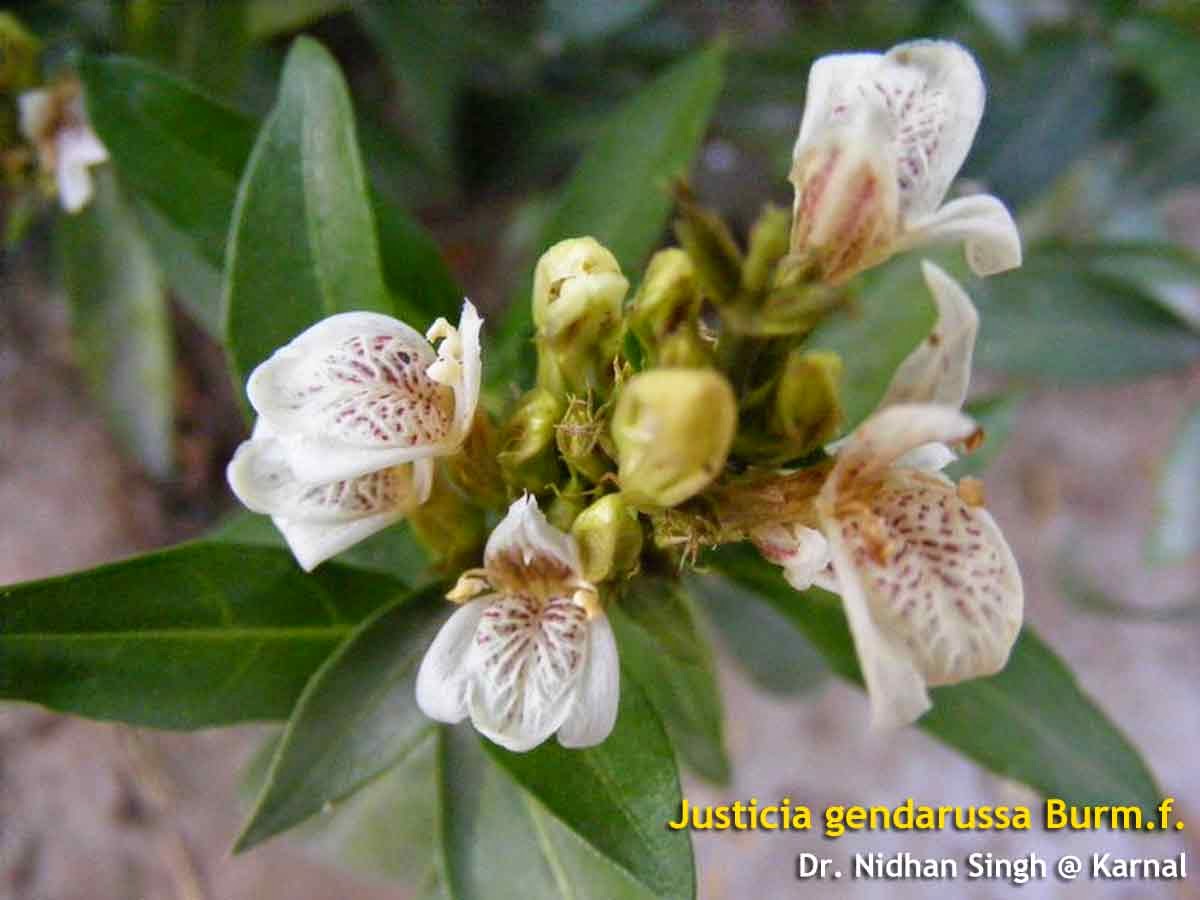Justicia gendarussa Burm.f.
Family: Acanthaceae
Synonyms: Dianthera subserrata Blanco, Dicliptera rheedei Kostel., Ecbolium gendarussa (Burm.f.) Kuntze, Ecbolium subserratum Kuntze, Gendarussa vulgaris Nees, Justicia dahona Buch.-Ham. ex Wall.
- English: willow-leaved justicia
- Assamese: tita-bahak, Bishalya Karani
- Asturian: Xusticia gendarussa
- Bengali: বাকস bakas, বাসা basa, Jagatmadan
- Chinese: 尖尾风
- French: Yapana marron
- Hindi: अडूसा adusa, बाकस bakas, बासा basa, नीली निर्गुण्ठी nili nirgunthi, वाशा vasha, Kala Bashimb
- Kannada: ಕರಿ ಲಕ್ಕಿ kari lakki, Karinekki, Karalakkigidde
- Malayalam: കറു നൊച്ചി karu nochchi, Vathamkolli
- Marathi: बाकस bakas, काळा अडुळसा kala adulasa
- Oriya: nila nirgundi
- Sanskrit: कसनः kasanah, वैध्यसिंहा vaidyasinha
- Sudanese: Handarusa
- Tamil: சேபாலிகை cepalikai, கருநொச்சி karu-nocci, காவி kavi, கோபி kopi, வாடாக்கொடி vata-k-koti, வாடைக்குற்றி vataikkurri
- Telugu: గంధరసము gandharasamu, నల్లవావిలి nallavaavili, నీలనిర్గుండి niilanirgundi
- Urdu: اڙوسا adusa, باکس bakas, باسا basa
- Vietnamese: Thanh táo
Description: Shrubs, branches dark purple, terete, smooth. Leaves 7-10 x 2 cm, linear or oblong-lanceolate, apex acute or obtuse, base acute, chartaceous, glabrous, lateral nerves 5-7 pairs, bluish; petiole 2-3 mm long. Spikes terminal, to 8 cm long, narrow; bracts linear, 4 mm long. Flowers white; calyx lobes linear-lanceolate, 5 mm long; corolla white with purple streaks, 1.5 cm long; ovary and style puberulus. Capsule 12 mm long, glabrous.
A potent anti-HIV compound more powerful than the drug AZT according to Journal of Natural Product article.
Used in Ayurveda, Unani and Sidha. Whole plant hypotensive, emetic, febrifuge; plant paste in coconut oil applied against rheumatic pain. Dried seed powder mixed with fruit decoction and used as insect repellent. Roots used for diuresis, diarrhea and as antidote; bark antipyretic, emetic, anti-cough, diuretic and anti-amebic, in the treatment of wounds and allergy; root extract mixed with water and taken as antidote, anti-venom. Leaves taken internally against cough, body pain, fever and as a cardio tonic, and used externally to treat inflammation, wounds and allergy; a poultice of leaves applied on inflammation; leaves infusion given in headache, hemiplegia and facial paralysis; leaf juice applied to check bleeding, also poured into ears for earache; leaves decoction a remedy for bloody diarrhea and fevers; leaves used in preparations to treat gonorrhea, amenorrhea and malaria, headache, rheumatism and pain; leaves and shoots diaphoretic, a decoction given in chronic rheumatism. Veterinary medicine, pounded leaves applied on bone fracture. Ritual, ceremonial, whole plant, with Ocimum sp. and Euphorbia neriifolia L., used for worship; leafy twigs used in the worship; leaves of Justicia gendarussa soaked with water and leaves of Dendrocnide stimulans, the water used in a ceremony for good hunting and harvest. [CRC World Dictionary of Medicinal and Poisonous Plants]
Febrifuge, diaphoretic, emetic, emmenagogue. Infusion of leaves—given internally in cephalalgia, hemiplegia and facial paralysis. Fresh leaves—used topically in oedema and rheumatism. Bark—
emetic. [Indian Medicinal Plants An Illustrated Dictionary]
In Indonesia, Justicia gendarussa Burm. f. is used to induce vomiting. In Malaysia, a decoction of 50 g of roots is used to treat rheumatic arthritis; boiled with ginger rhizome and lime, it is used to alleviate bleeding cough. A decoction of the leaves is used to combat fever, promote menses, assuage stomach discomfort, check haemoptysis, alleviate cough, treat asthma, and to relieve the bowels of costiveness. The fresh leaves are pounded and used externally to treat pyoderma, lumbago and rheumatism. A paste of leaves mixed with vinegar is used to assuage toothache. Justicia gendarussa Burm. f. is also used during the hot stages of malaria to combat fever and to treat leucorrhea. InVietnam, the plant is used to resolve tumors, promote appetite, and to invigorate health. In India, the plant is used to treat bronchitis, soothe inflammation, and to promote digestion. [Medicinal Plants: Drugs For The Future? ]
Treats rheumatism and fever, antipyretic, effects on nitric oxide and tumor necrosis, antiinflammatory, antihypersensitivity, and antihistaminic effects. [Taiwanese Native Medicinal Plants: Phytopharmacology and Therapeutic Values]
97 published articles of Justicia gendarussa



